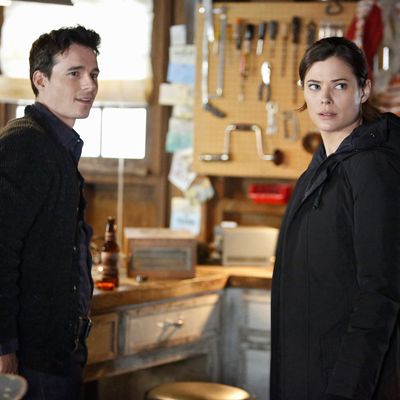
Frequency is either an example of a likable, but redundant movie adapted into a series, or an example of why networks shouldnÔÇÖt only make pilots of new shows available to critics. Because IÔÇÖve only seen the pilot, I have no way of knowing for sure which kind of show it is. ItÔÇÖs heartfelt and likable, but doesnÔÇÖt quite justify its existence.
The 2000 feature film by writer Toby Emmerich and director Gregory Hoblit tells of a firefighter named Frank Sullivan and his police detective son, John (Dennis Quaid and Jim Caviezel, respectively), who connect across time via shortwave radio, repair their relationship, and unleash catastrophic change upon the present. It was a fine example of a modestly budgeted genre film made memorable by strong performances, a believable and affecting central relationship, and a sturdy, clever plot that integrated notions of parallel timelines into a tale that was gripping even if you werenÔÇÖt especially interested in having a wonky discussion about the scientific theories driving the storytellersÔÇÖ choices. The pilot to the CW series version trades father-son bonding for father-daughter bonding (the detective is now named Raimy Sullivan, and played by Peyton List) and turns her father, Frank (Riley Smith), into an undercover cop who walked out on his family, died during a botched undercover operation in 1996, and is widely believed to have been corrupt.
If youÔÇÖve seen the movie, none of the pilotÔÇÖs twists will surprise you. The script moves key elements around, retools others (the cop stuff is naturally more prominent now that there are two in the family), and gives Raimy a boyfriend whoÔÇÖs thinking of proposing to her (she found an engagement ring in his shaving kit). ItÔÇÖs different mainly in the placement of the original filmÔÇÖs subsidiary but related hunt for a serial murderer known as the Nightingale Murderer (which sounds like a groaner if you havenÔÇÖt seen the movie, but youÔÇÖd be surprised how well it works there), and for the way it warms up and complicates the central relationship by casting a woman in the lead role. Father-daughter dynamics are just different from father-son dynamics, even when the daughter in question is a ÔÇ£tomboyÔÇØ (the showÔÇÖs word, not mine), mainly because of social conditioning placed upon both parties. Frequency the show doesnÔÇÖt get into any of this explicitly, which is probably wise considering network TVÔÇÖs terrible track record discussing gender roles in an organic, non-clunky way; but itÔÇÖs carried as subtext through ListÔÇÖs performance, whoÔÇÖs much less emotionally constricted than CaviezelÔÇÖs version of the character ÔÇö more open about her emotional damage, and generally more empathetic and responsive in moments of stress.
SmithÔÇÖs John Sullivan contrasts with her nicely: HeÔÇÖs a Frank SerpicoÔÇôstyled scruffy tough guy, with facial hair and a cool leather jacket. The show has the good sense to refute the old story about him being corrupt pretty quickly (we never wouldÔÇÖve believed it anyway; this is a network show) and get on with the business of figuring out why he was killed and finding a way for Raimy to prevent it. Would it surprise you to learn that there was a conspiracy, and that police know more than theyÔÇÖre telling?
The high point of the show is a four-minute radio conversation between Raimy and Frank that rips the scabs off old wounds and begins healing them, all while setting the remainder of the plot in motion. List and Sullivan are both so strong in this self-contained scene that it makes the rest of the pilot ÔÇö a sprint through a typically exposition-choked script, with a crosscut climax seemingly modeled on a particular Christopher Nolan film ÔÇö feel comparatively unremarkable.
Like another current time-travel show, NBCÔÇÖs Timeless, this one is meticulous in noting all the ways that the present can change as a result of futzing with the past. But where Timeless seems to be positing a single timeline that can be rewritten by traveling backward, Frequency has Raimy tell us that ÔÇ£time is really parallel,ÔÇØ with narrative lines running alongside each other like railroad tracks separated by an invisible but surprisingly permeable membrane. The show expresses this idea (as the film did before it) by juxtaposing the present and the past like a mirror and its reflection, or like the real versus the Upside Down in Stranger Things: Frank rests a burning cigarette on the shortwave while talking to Raimy, and Raimy sees burn marks appear on the casing, etc. The most fascinating aspect of the show is its decision to let the ÔÇ£oldÔÇØ pristine future and the newly altered one exist side by side in RaimyÔÇÖs memory, rather like the two versions of Frequency that now exist in the minds of viewers whoÔÇÖve seen both. ItÔÇÖs a bright idea, redolent of much headier science fiction that weÔÇÖre used to seeing on commercial TV, but thereÔÇÖs no way to tell right now if Frequency can build on it. Viewers who come into the show with no knowledge of the original movieÔÇÖs plot will surely appreciate it more, because the recycled stuff will feel new to them, and the new stuff will feel even newer.


